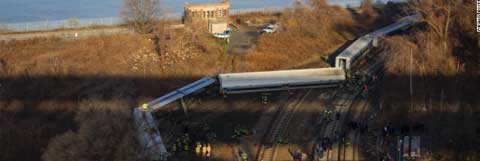
Investigators continue to search for answers after New York City’s deadliest train derailment in more than 20 years, which claimed the lives of 4 people Sunday and injured dozens more to close the holiday weekend on a tragic note.
The crash of the speeding commuter train in the Bronx had an impact across the region, inspiring vigils, sparking travel complications along Metro-North Railroad’s Hudson River line and setting an extensive investigation into motion. The National Transportation Safety Board is tasked with establishing exactly what happened and why, and police and prosecutors are conducting a separate inquiry to determine if a crime was committed, the New York Times reported.
Under intense scrutiny are Metro-North, which is already under investigation for a pair of accidents earlier this year, and William Rockefeller, the engineer who may have “zoned out” behind the controls of the speeding train.
Dozens of affected families — as well as millions of others in this city dependent on trains and other types of public transit — are waiting for answers.
What We Know
While the investigation must still take its course, a pair of things appear clear from what has emerged: the train was going much too fast as it headed into a 30-mile-per-hour curve from a 70-mile-per-hour section of track, and Rockefeller applied the brakes too late. The Times reported the train was traveling 82 miles per hour when it derailed on the curve. That’s more than 2.5x too fast, and a train traveling at that speed can take up to a mile to stop, according to the Associated Press.
Until their work is done, investigators can’t say with certainty whether the excessive speed was the result of a mechanical problem or operator error. But news broke Tuesday that Rockefeller allegedly told investigators he “zoned out” as the train headed into the the curve, the Post reported, resuming control only after an emergency whistle sounded because of the high speed.
“I was in a daze … the next thing I know I was hitting the brakes,” Rockefeller allegedly told authorities, a law enforcement source told the Daily News.
Rockefeller has been tested for drugs and alcohol, and investigators have seized his cell phone. A railroad workers’ union official told the Associated Press that Rockefeller has an “impeccable record” in two decades with Metro-North, including about 11 years as an engineer.
 The train’s two black boxes indicate that the throttle was fully engaged as the train headed into the curve and was released just 6 seconds before the crash, the Times reported. The brakes were applied in full force a second later — “very late in the game,” an NTSB board member said at a press conference.
The train’s two black boxes indicate that the throttle was fully engaged as the train headed into the curve and was released just 6 seconds before the crash, the Times reported. The brakes were applied in full force a second later — “very late in the game,” an NTSB board member said at a press conference.
Before it derailed, the train had made 9 stops on its run without incident, officials said, casting doubt that a brake problem could be to blame. Officials said there appeared to be no problem with the track, either.
Technology exists to prevent exactly the sort of operator error being eyed as a possible cause in Sunday’s disaster. It is known as positive train control, and federal law requires Metro-North and other U.S. railroad companies to install it by the end of 2015, the Post reported. The Metropolitan Transportation Authority, which oversees public transportation throughout greater New York, is requesting an extension to 2018.
Portraits Emerge of Victims
In the news media, many New Yorkers recalled their first thought upon hearing of the crash: I’ve rode on that line. It could have been me.
So it’s no surprise that the 4 people whose lives were cut short were much like the rest of us, devoted to family, work and community. Each now has a personality and a story, thanks to reports like this one from the Wall Street Journal.
 James Lovell, a 58-year-old father of four who worked as an audio technician, was on his way to Rockefeller Center to prepare the famous Christmas tree for its annual opening.
James Lovell, a 58-year-old father of four who worked as an audio technician, was on his way to Rockefeller Center to prepare the famous Christmas tree for its annual opening.- A paralegal, tax collector and lifelong volunteer, 54-year-old Donna Smith was scheduled to sing Handel’s “Messiah” before an audience with her sister Sunday night. The two were planning to spend the day together in New York.
- James Ferrari, 59, was taking the same trip he took 6 times each week from his Westchester County home to his job in midtown Manhattan as a building supervisor. Neighbors described him as devoted to his wife and daughter.
- Ahn Kisook, a 35-year-old nurse, was returning to her Queens apartment after a long shift at a children’s hospital in Ossining. She came to the U.S. from Korea in 2008 to earn a master’s degree and work with sick children.
At 7:22 a.m. Sunday, just shy of the Spuyten Duyvil stop and within sight of the Henry Hudson Bridge, a kind singing voice was silenced forever in the roar of twisting metal. Two fathers were suddenly taken from their children. Employers lost dedicated employees, and children battling illness lost a devoted caretaker who traveled halfway around the world to be by their side.
Grief – And Questions
Right now, 4 families are dealing with the grief of losing a loved one with whom they may have enjoyed a Thanksgiving dinner just days ago. This grief will stay with them forever. But the initial shock will soon settle, and those who loved these 4 victims will begin demanding answers when it does. They should. These families deserve to know what happened.
And in this metropolis unimaginable without its trains, subways and other forms of public transit, the rest of us deserve to know the truth, too.
Photo Credit: CNN.com



